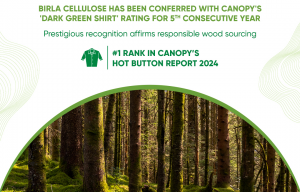
Birla ranks top in Canopy’s 2024 Hot Button Report
The visibility of forest sources for all the Birla Cellulose’s eco-enhanced products has been achieved by collaboration with Sappi Ltd., the largest supplier of dissolving pulp.

5th November 2020
Knitting Industry
|
Mumbai, India

Birla Cellulose has advanced the capability of the well-established blockchain-enabled traceability platform, GreenTrack, which now enables consumers to see the forests from where the wood is sourced and thus providing a complete end-to-end visibility of forest to fashion. The visibility of forest sources for all the Birla Cellulose’s eco-enhanced products has been achieved by collaboration with Sappi Ltd., the largest supplier of dissolving pulp. The forest information of pulp produced by Birla Cellulose was available on the platform thus far.
The GreenTrack platform was introduced in early 2019 and has since been used widely to trace and track the material flow in the fashion value chain, and is currently being used by over 20 leading global brands and retailers and their respective supply chain partners across the globe, while many others are in the process of onboarding it, Birla Cellulose says.
In addition to brands, many large garment producers and exporters are also using the platform to trace their supply chains. The traceability of the value chain through the use of this platform comes without any additional cost to the supply chain partners or to the brands and retailers. This unique platform already handles thousands of ‘live’ transactions and has a potential to reach millions of consumers across the globe. Brands have started to pass on the power of traceability to their end consumers through QR codes on their garment hangtags, Birla Cellulose explains.
“Expanding the capability of the GreenTrack platform and our collaboration with Sappi to provide the visibility of sustainably managed forests from where the wood was sourced, would help the sustainability focused consumers, brands and retailers to make a more informed buying decision,” said Mukul Agrawal, Chief Sustainability Officer of Birla Cellulose. “This initiative simplifies the verification of sustainability of complete supply chain, from forest to retail, validation of which otherwise would be a cumbersome process involving compilation of many certifications and manual tracking of the material in a long complex value chain.”
“This is one more step towards our commitment for building a fully transparent supply chain and creating visibility to the sustainably managed forests, that are among the most important aspect of responsibly produced viscose. Birla Cellulose leads sustainable wood sourcing practices in MMCF industry and ranks no. 1 in Canopy’s Hot Button Report 2020 that ranks the MMCF producers on sustainable wood sourcing practices and next generation solutions.”
Krelyne Andrew, General Manager, Sustainability for Sappi Verve, commented: “We are committed to enhancing trust and creating shared value within our supply chain, working closely with our partners to promote and shape the sustainability of the MMCF sector towards a Net Positive vision.”
Traceable and transparent supply chains are integral steppingstones to providing brand owners and consumers with the confidence that their products originate from sustainable and renewable sources of wood, free from deforestation, where biodiversity is promoted and customary, traditional or civil rights of people are upheld, the company adds.
The platform is unique in the sense that it tracks orders as well as shipments (actual material flow) at the same time, thereby, eliminating any chance of inconsistent practices in the supply chain. The platform ensures information access only to relevant parties and full details of transparent supply chain is visible to end buyers or brands only. In addition to live tracking of material, the platform offers a series of value-added features such as auto-generation of transaction certificates, easing quality management efforts, business analytics, amongst other features, Birla Cellulose concludes.

Business intelligence for the fibre, textiles and apparel industries: technologies, innovations, markets, investments, trade policy, sourcing, strategy...
Find out more